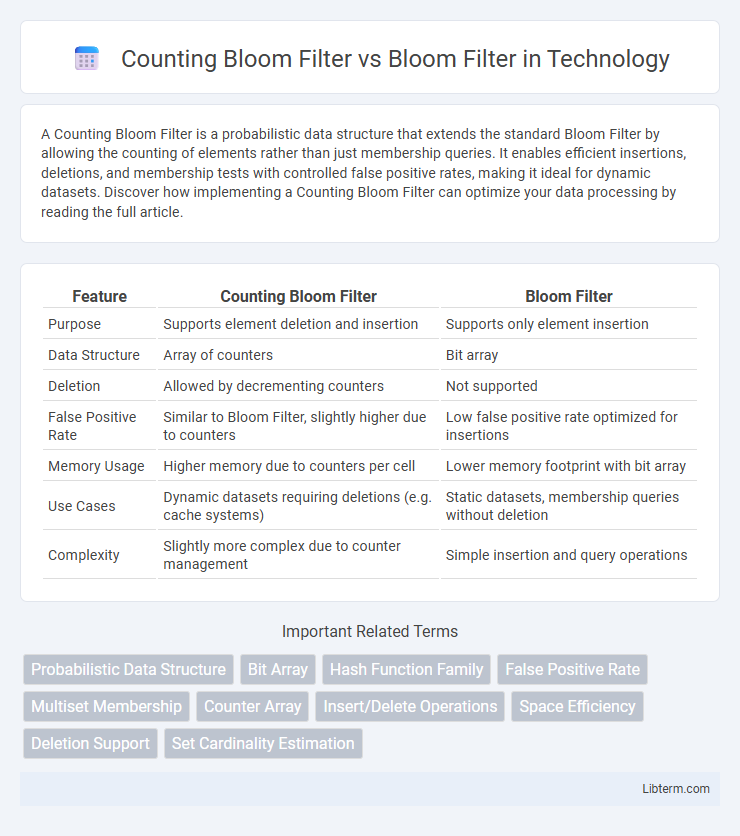A Counting Bloom Filter is a probabilistic data structure that extends the standard Bloom Filter by allowing the counting of elements rather than just membership queries. It enables efficient insertions, deletions, and membership tests with controlled false positive rates, making it ideal for dynamic datasets. Discover how implementing a Counting Bloom Filter can optimize your data processing by reading the full article.
Table of Comparison
| Feature | Counting Bloom Filter | Bloom Filter |
|---|---|---|
| Purpose | Supports element deletion and insertion | Supports only element insertion |
| Data Structure | Array of counters | Bit array |
| Deletion | Allowed by decrementing counters | Not supported |
| False Positive Rate | Similar to Bloom Filter, slightly higher due to counters | Low false positive rate optimized for insertions |
| Memory Usage | Higher memory due to counters per cell | Lower memory footprint with bit array |
| Use Cases | Dynamic datasets requiring deletions (e.g. cache systems) | Static datasets, membership queries without deletion |
| Complexity | Slightly more complex due to counter management | Simple insertion and query operations |
Introduction to Bloom Filters
Bloom Filters are space-efficient probabilistic data structures used to test whether an element is part of a set, allowing false positives but no false negatives. Counting Bloom Filters extend this concept by enabling element deletions through an array of counters instead of simple bits, which is not possible with standard Bloom Filters. Both structures rely on multiple hash functions to map elements to positions in their respective arrays, balancing accuracy with memory usage.
Understanding Counting Bloom Filters
Counting Bloom Filters extend traditional Bloom Filters by enabling element deletion through an array of counters instead of simple bits, allowing incremental updates and removals. Each counter tracks the number of insertions of an element hashed to a given position, supporting dynamic data sets where membership changes over time. This capability makes Counting Bloom Filters more versatile for applications requiring both membership queries and modifications, such as network routers and database systems.
Core Differences Between Bloom and Counting Bloom Filters
Counting Bloom Filters differ from standard Bloom Filters primarily by supporting deletion operations through maintaining a counter for each bit, whereas Bloom Filters only allow set membership queries without deletion capability. Each position in a Counting Bloom Filter contains a small counter that increments on element insertion and decrements on deletion, enabling dynamic updates while preserving probabilistic accuracy. Bloom Filters use fixed-size bit arrays resulting in only insertions and queries, but no ability to remove elements without reconstructing the entire filter.
How Standard Bloom Filters Work
Standard Bloom Filters operate by hashing an element through multiple independent hash functions, each producing a position in a bit array that is set to 1, enabling fast membership tests with space efficiency and a controlled false positive rate. These filters do not store the element itself but rely on this probabilistic representation to check if an item might be in the set or definitely not in it. The limitation lies in their inability to delete elements without false negatives, which Counting Bloom Filters address by using a counter array instead of bits to support element removal.
How Counting Bloom Filters Work
Counting Bloom Filters enhance traditional Bloom Filters by maintaining a counter for each bit position instead of a single bit, allowing efficient element deletion and updating. Each inserted element increments counters at multiple hash-derived positions, while removals decrement these counters, ensuring accurate membership queries without false negatives. This counter-based approach provides dynamic set operations with controlled false-positive rates, making Counting Bloom Filters suitable for applications requiring frequent updates.
Pros and Cons of Bloom Filters
Bloom Filters provide an efficient probabilistic data structure for membership testing with minimal memory usage and fast query times but suffer from false positives and inability to delete elements. Counting Bloom Filters extend this functionality by allowing element deletions through counters, enhancing flexibility but at the cost of increased memory consumption and complexity. False positives and fixed-size capacity remain limitations for both, requiring careful tuning for optimal performance.
Pros and Cons of Counting Bloom Filters
Counting Bloom Filters provide the advantage of supporting element deletions, unlike standard Bloom Filters that only allow insertions, making them more flexible for dynamic datasets. Their main drawback is increased memory consumption and complexity due to maintaining counters instead of simple bits, which can impact performance in resource-constrained environments. Counting Bloom Filters are ideal for applications requiring precise membership updates but may incur overhead compared to traditional Bloom Filters optimized for memory efficiency.
Use Cases for Bloom Filters
Bloom Filters are highly efficient for membership testing in applications such as database query optimization, network packet filtering, and caching, where false positives are acceptable but false negatives are not. Counting Bloom Filters extend this functionality by supporting element deletion and dynamic set changes, making them ideal for use cases like network intrusion detection and distributed systems requiring frequent updates. Standard Bloom Filters excel in static datasets with minimal insertions or deletions, optimizing memory usage while ensuring fast membership queries.
Applications of Counting Bloom Filters
Counting Bloom Filters excel in dynamic datasets where insertions and deletions are frequent, such as network intrusion detection systems and database synchronization. Unlike traditional Bloom Filters, they maintain a count array that allows precise element removal, making them ideal for real-time analytics and caching systems. Their ability to track item frequencies also benefits streaming data processing and approximate membership queries in distributed systems.
Choosing Between Bloom Filter and Counting Bloom Filter
Choosing between a Bloom Filter and a Counting Bloom Filter depends on the need for element deletion and update operations. Bloom Filters provide efficient space-saving membership tests with false positives but do not support deletions, while Counting Bloom Filters extend functionality by maintaining counters for each bit, enabling element removals and dynamic updates. For applications requiring mutable sets or tracking frequencies, Counting Bloom Filters offer greater flexibility despite slightly higher memory usage.
Counting Bloom Filter Infographic

 libterm.com
libterm.com